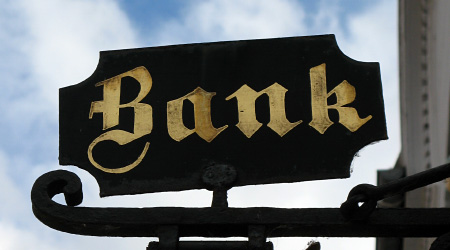How Does A Bank Make Money?

Banks and other financial institutions earn their income from a variety of different sources. Some of these sources have been around forever and others are of more modern creation. Regardless, there are certain constants that all financial institutions use to make money. The federal government through multiple United States agencies including the Federal Deposit Insurance Corporation and Federal Reserve Board as well as state agencies grant financial institutions a banking license at which point they can receive deposits and issue loans. Therefore loans are the primary revenue generating instrument banks use in addition to collecting fees from day-to-day activities.
A bank or credit union traditionally receives deposits from consumers and then issues loans to other individuals or small businesses. The deposits normally go into either checking or saving accounts which pay a nominal and often very low interest rate. The funds which are deposited are then lent to others as home mortgages, home equity lines of credit, signature loans or small business loans. As many consumers know who have both an outstanding mortgage and a savings account the differences in interest can be significant. It is not unheard of for a savings account to make 0.5% interest while paying a mortgage with a fixed rate of 5%. The 4.5% interest is where a bank or credit union makes its money. That's a simplified look as there are expenses with operating any business so it's not pure profit but essentially that's how a bank makes money.
Most financial institutions however do not limit their business activities to simply taking deposits and issuing loans. They often supplement their income by issuing Certificates of Deposit or CDs as well as offering other investment services such as Money Market Accounts and IRAs. Certificates of deposit works similar to customer deposits in that the funds are given a slightly better rate of return but are locked in for a fixed period of time so the bank can use the funds to issue loans. Investment accounts on the other hand usually incur management fees for maintaining the account as an administration expense.
Banks and credit unions found out long time ago that they can make even more money not just by offering products or services and then using the deposits for loans but by also charging their customers various penalty fees just for the opportunity to use those services. A more recent example is a minimum account balance fee where a checking or savings account must maintain a average minimum monthly balance or incur a maintenance fee. Institutions also charge penalties for overdrawing a checking account also known as bouncing a check. Unlike the $2-$3 charged for a minimum balance the insufficient funds fees also known as NSF can range anywhere from $20-$30 per overdrawn check.
In the 80s and 90s it was common for checks presented to banks for payment, whether were not enough funds available, to simply be denied and reported that there are insufficient funds. More recently however they soon realized that it's better to cover the check and offer a service called a courtesy overdraft or overdraft protection. That way they can charge a monthly fee for this additional "service" and still benefit if the account stays overdrawn for too long. Even if this service is not offered, many banks will still allow the check to clear and simply charge an overdraft fee.
Fees are also charged for withdrawing funds from Automated Teller Machines known as ATMs when those ATMs are out-of-network. CUAnytime ATMs are part of the network operated by credit unions and do not incur a fee for those members on the network but there's more than one network available. If a checking account holder wishes to use an ATM that is outside their network they will often have to pay a fee of up to $2.50. When using an ATM verify it is part of your network to avoid this unnecessary and frankly egregious fee imposed on consumers.
Needless to say there are many different revenue sources that banks use to make money. How a bank makes money is only limited by their imagination and consumer backlash against increased fees and penalties. While some of these revenue streams make sense such as charging more for a loan than with what is paid on a savings account or CD other sources are more reprehensible such as ATM fees and overdraft fees. The best thing consumers can do is shop around and let competition provide the best consumer experience by getting great deals on loans and keeping fees and penalties to an absolute minimum.
Elsewhere on StockMonkeys.com







